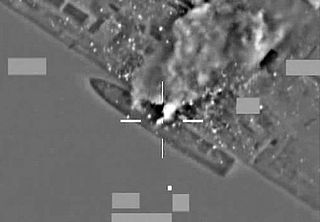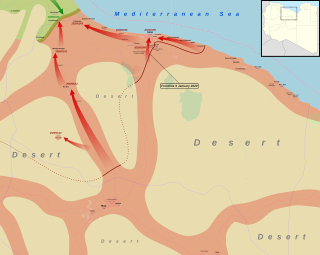See also
- Battle of the Misrata frontline, during the 2011 Libyan Civil War (May to August)
Battle of Misrata may refer to:

Misrata is a city in the Misrata District in northwestern Libya, situated 187 km (116 mi) to the east of Tripoli and 825 km (513 mi) west of Benghazi on the Mediterranean coast near Cape Misrata. With a population of about 881,000, it is the third-largest city in Libya, after Tripoli and Benghazi. It is the capital city of the Misrata District and has been called the trade capital of Libya. The harbor is at Qasr Ahmad.

Tripoli International Airport was an international airport built to serve Tripoli, the capital city of Libya. The airport is located in the area of Qasr bin Ghashir, 24 kilometres (15 mi) from central Tripoli. It used to be the hub for Libyan Airlines, Afriqiyah Airways, and Buraq Air.

Sirte, also spelled Sirt, Surt, Sert or Syrte, is a city in Libya. It is located south of the Gulf of Sirte, between Tripoli and Benghazi. It is famously known for its battles, ethnic groups, and loyalty to Muammar Gaddafi. Also due to its development, it was the capital of Libya as Tripoli's successor after the Fall of Tripoli from 1 September 2011 to 20 October 2011. The settlement was established in the early 20th century by the Italians, at the site of a 19th-century fortress built by the Ottomans. It grew into a city after World War II.

Tawargha, also transliterated Tawarga, Tauorga, Taworgha, Tawurgha or Torghae, is, as of May 2021, a former ghost town in Libya that is under administrative jurisdiction of the city of Misrata, which is 38 kilometers away. It was the site of intense fighting during the Libyan Civil War before it was captured and forcibly evacuated by anti-Gaddafi forces in August 2011.
The media of Libya consists of a broad range of newspapers, TV channels, radio stations, and websites mostly set up during or after the Libyan Civil War, which removed previously tight restrictions on freedom of the press and freedom of speech. By the summer of 2012, there were over 200 registered newspapers, over 20 TV channels, and 200 radio stations.

Misrata Airport is an international airport serving Misrata, a Mediterranean coastal city in the Misrata District of Libya. It also acts as an air base and training center for the Libyan Air Force.

The Fist Crushing a U.S. Fighter Plane Sculpture is a gold-coloured monument located in Misrata, Libya. It was once located at the Bab al-Azizia compound in the Libyan capital of Tripoli. The sculpture was commissioned by the nation's leader, Colonel Muammar Gaddafi following the 1986 bombing of Libya by United States aircraft. It was built in the shape of an arm and hand squeezing a fighter plane. It may have been designed to symbolize the apparent downing of an F-111 by Libyan anti-air units in the 1986 bombing.

The Battle of Misrata, also known as the Siege of Misrata, was a battle of the 2011 Libyan Civil War for the control of Misrata. It was fought between troops loyal to the government of Muammar Gaddafi, and anti-Gaddafi rebels who held Misrata, the third largest city in Libya. Following the initial stages of the uprising, the Libyan government took back most towns in the west of the country, leaving Misrata the only major city under rebel control in Tripolitania. The city soon became the site of one of the war's major battles and the suffering of its citizens gained worldwide attention.
Khamis Gaddafi was the seventh and youngest son of former Libyan leader Muammar Gaddafi, and the military commander in charge of the Khamis Brigade of the Libyan Army. He was part of his father's inner circle. During the Libyan Civil War in 2011, he was a major target for opposition forces trying to overthrow his father.

The National Liberation Army, formerly known as the Free Libyan Army, was a Libyan military organisation affiliated with the National Transitional Council, which was constituted during the First Libyan Civil War by defected military members and civilian volunteers, in order to engage in battle against both remaining members of the Libyan Armed Forces and paramilitia loyal to the rule of Muammar Gaddafi. It had prepared for some time in portions of Eastern Libya controlled by the anti-Gaddafi forces for eventual full-on combat in Western Libya against pro-Gaddafi militants, training many men before beginning to go on the offensive. They have battled for control of Benghazi, Misrata, Brega, Ajdabiya, Zawiya and Ra's Lanuf as well as several towns in the Nafusa Mountains. They finally began the Battle for Tripoli in August 2011 when they attacked from the west of the city, as well as fomenting an internal uprising on 20 August.

Operation Ellamy was the codename for the United Kingdom participation in the 2011 military intervention in Libya. The operation was part of an international coalition aimed at enforcing a Libyan no-fly zone in accordance with the United Nations Security Council Resolution 1973 which stipulated that "all necessary measures" shall be taken to protect civilians. The coalition operation was designated by NATO as Operation Unified Protector, by the US as Operation Odyssey Dawn. The Canadian participation as Operation Mobile and the French participation as Opération Harmattan. It was confirmed in December 2011 that the cost of the operations was £212m – less than was estimated, including £67m for replacing spent munitions, is all expected to be met from the Treasury reserve.

Operation Mobile was the name given to Canadian Forces activities in the 2011 military intervention in Libya. The United States' counterpart to this was Operation Odyssey Dawn, the French counterpart was Opération Harmattan and the British counterpart was Operation Ellamy. The no-fly zone was proposed during the Libyan Civil War to prevent government forces loyal to Muammar Gaddafi from carrying out air attacks on anti-Gaddafi forces and civilians. The demonstrations in Libya were part of the larger Arab Spring movement that began in the country of Tunisia on 18 December 2010. When demonstrations began in Libya, the government of Muammar Gaddafi responded with systematic attacks by air and ground forces, and repression of the protesters. In a speech, Gaddafi promised to chase down the protesters and cleanse the country "house by house". Several countries prepared to take immediate military action at a conference in Paris on 19 March.

Voice of Free Libya is the name used by three radio stations aligned to the anti-Gaddafi forces that began broadcasting in February 2011, operating from the cities of Benghazi, Bayda and Misrata. They played an important role in the Libyan Civil War and have continued to broadcast after the fall of Gaddafi.
The outbreak of the Libyan Civil War was followed by accusations of human rights violations by rebel forces opposed to Muammar Gaddafi, Gaddafi's armed forces, and NATO. The alleged violations include rape, extrajudicial killings, ethnic cleansing, misconduct and bombings of civilians.
The Battle of the Misrata frontline was a battle during the Libyan Civil War between pro-Gaddafi loyalists and anti-Gaddafi forces on the western and southwestern outskirts of Misrata, the third largest city in Libya. It ended when anti-Gaddafi soldiers secured Zliten to the west and Tawergha to the south, establishing a significant buffer zone around the city.

The timeline of the First Libyan Civil War begins on 15 February 2011 and ends on 20 October 2011. It begins with a series of peaceful protests, similar to others of the Arab Spring, later becoming a full-scale civil war between the forces loyal to Muammar Gaddafi's government and the anti-Gaddafi forces. The conflict can roughly be divided into two periods before and after external military intervention authorized by United Nations Security Council Resolution 1973.
The Battle of Tawergha was a military engagement of the Libyan Civil War that began on 11 August 2011 when anti-Gaddafi forces based in Misrata advanced southeast along the road to Sirte in the early morning and attacked Libyan Army positions in the town of Tawergha. It ended on 13 August when rebel troops, after capturing the town, cleared it of snipers and artillery positions threatening Misrata.
The Zliten uprising was a local uprising in the Libyan Civil War, started by rebel anti-Gaddafi forces against loyalist pro-Gaddafi forces in the city of Zliten. The city was of strategic importance due to its close proximity to the capital of Tripoli. After Zliten, only two cities – Khoms and Tajura – separated the rebel stronghold of Misrata from Tripoli.

The Libyan Civil War began on 15 February 2011 as a civil protest and later evolved into a widespread uprising. However, by 19 March, Libyan forces under Colonel Muammar Gaddafi were on the brink of a decisive victory over rebels in Libya's east. That day, leading NATO members acted on United Nations Security Council Resolution 1973 which authorized member states "to take all necessary measures... to protect civilians and civilian populated areas under threat of attack in the Libyan Arab Jamahiriya, including Benghazi, while excluding an occupation force".

The Battle of Sirte took place on January 6, 2020 during the Second Libyan Civil War. The Libyan National Army of Marshal Khalifa Haftar took the city from the forces of the Fayez el-Sarraj Government.